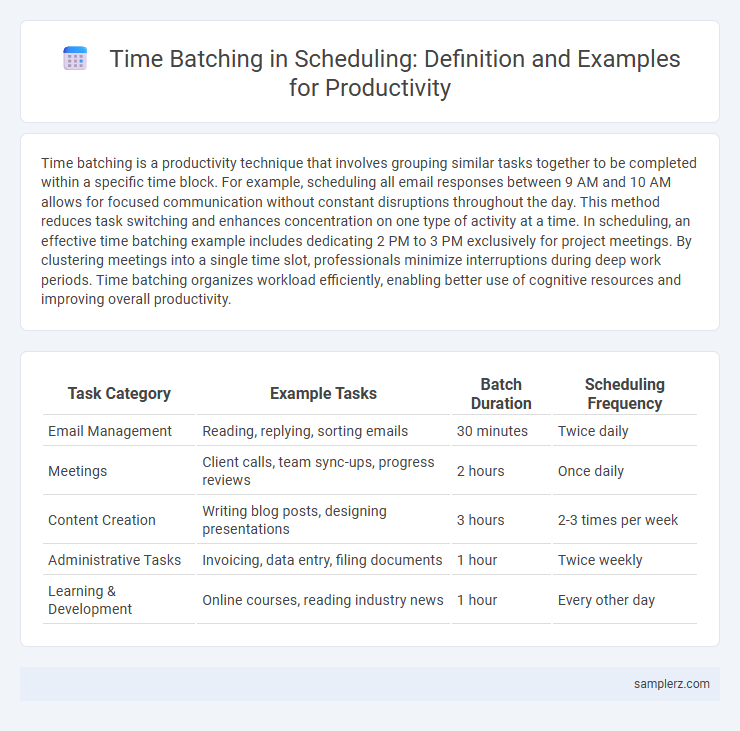Time batching is a productivity technique that involves grouping similar tasks together to be completed within a specific time block. For example, scheduling all email responses between 9 AM and 10 AM allows for focused communication without constant disruptions throughout the day. This method reduces task switching and enhances concentration on one type of activity at a time. In scheduling, an effective time batching example includes dedicating 2 PM to 3 PM exclusively for project meetings. By clustering meetings into a single time slot, professionals minimize interruptions during deep work periods. Time batching organizes workload efficiently, enabling better use of cognitive resources and improving overall productivity.
Table of Comparison
| Task Category | Example Tasks | Batch Duration | Scheduling Frequency |
|---|---|---|---|
| Email Management | Reading, replying, sorting emails | 30 minutes | Twice daily |
| Meetings | Client calls, team sync-ups, progress reviews | 2 hours | Once daily |
| Content Creation | Writing blog posts, designing presentations | 3 hours | 2-3 times per week |
| Administrative Tasks | Invoicing, data entry, filing documents | 1 hour | Twice weekly |
| Learning & Development | Online courses, reading industry news | 1 hour | Every other day |
Understanding Time Batching in Scheduling
Time batching in scheduling involves grouping similar tasks together and allocating specific blocks of time to complete them, reducing the cognitive load of switching between different activities. For example, setting aside two hours in the morning exclusively for answering emails and returning calls enhances focus and efficiency by minimizing distractions. This technique leverages the brain's ability to concentrate on one type of activity, promoting deeper work and improved time management.
Daily Planning Using Time Batching
Daily planning using time batching involves grouping similar tasks, such as emails, phone calls, and administrative work, into dedicated blocks of time to minimize context switching and increase focus. For example, setting aside two hours in the morning exclusively for answering emails and another hour in the afternoon for meetings enhances workflow efficiency. This method leverages focused energy periods, ultimately boosting overall productivity and reducing task fragmentation throughout the day.
Time Batching for Email Management
Time batching for email management involves dedicating specific blocks of time solely to reading, responding, and organizing emails, reducing constant inbox interruptions. Scheduling two or three focused sessions daily leverages deep work principles to enhance concentration and minimize task-switching costs. This approach fosters higher productivity by streamlining communication workflows and preventing email overload.
Grouping Meetings with Time Batching
Grouping meetings with time batching maximizes productivity by consolidating multiple appointments within specific time blocks, reducing frequent context switching. This method leverages calendar tools to allocate consecutive meeting slots, freeing up larger intervals for focused work. Implementing time batching in scheduling enhances efficiency and minimizes disruptions throughout the workday.
Content Creation Through Time Batching
Time batching in content creation involves allocating specific blocks of time to focus solely on tasks like writing, editing, or designing, minimizing task-switching and enhancing creative flow. For instance, dedicating mornings to drafting blog posts and afternoons to multimedia editing ensures concentrated effort and higher output quality. This method significantly boosts productivity by streamlining content workflows and reducing distractions.
Task Prioritization with Batch Scheduling
Task prioritization with batch scheduling organizes similar activities into focused time blocks, maximizing efficiency and minimizing context switching. For example, allocating mornings solely to high-priority email responses and afternoons to project development ensures deep work periods and reduces distractions. This method leverages cognitive focus on related tasks, enhancing productivity and time management accuracy.
Time Batching for Administrative Work
Time batching for administrative work involves grouping similar tasks such as responding to emails, filing documents, and processing invoices into specific blocks of time to minimize task-switching and increase focus. Scheduling dedicated sessions for these activities enhances efficiency by reducing distractions and allowing for deeper concentration. This method leverages the brain's capacity for sustained attention, resulting in higher productivity and reduced cognitive fatigue.
Batch Scheduling for Creative Processes
Batch scheduling in creative processes involves grouping similar tasks, such as brainstorming ideas or editing content, into dedicated time blocks to enhance focus and reduce cognitive switching. This approach capitalizes on the brain's natural flow state, allowing for deeper immersion and improved output quality. Research highlights that batching creative tasks can increase productivity by up to 40%, streamlining project timelines and fostering innovation.
Time Batching in Remote Team Collaboration
Time batching in remote team collaboration involves grouping similar tasks like meetings, emails, and project updates into specific time blocks to minimize context switching and improve focus. Tools such as shared calendars and project management platforms like Asana or Trello enable synchronized batching, enhancing team alignment and reducing communication delays. Implementing time batching increases productivity by creating predictable work periods and maximizing deep work sessions in a distributed work environment.
Optimizing Personal Routines with Time Batching
Time batching enhances productivity by grouping similar tasks into dedicated time blocks, reducing cognitive switching and increasing focus. For example, scheduling email responses exclusively between 9:00 AM and 10:00 AM minimizes distractions and streamlines communication workflows. Implementing time batching in daily routines, such as setting specific periods for meetings, administrative tasks, and creative work, maximizes efficiency and supports sustained concentration.

example of time batching in scheduling Infographic
 samplerz.com
samplerz.com